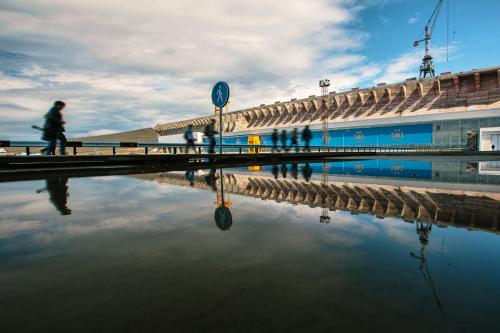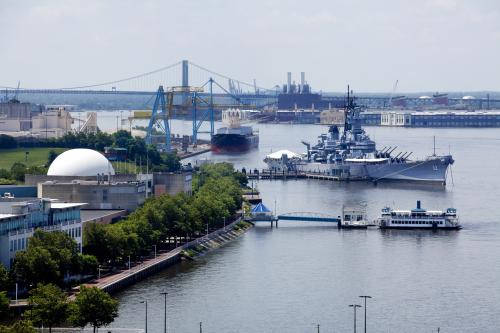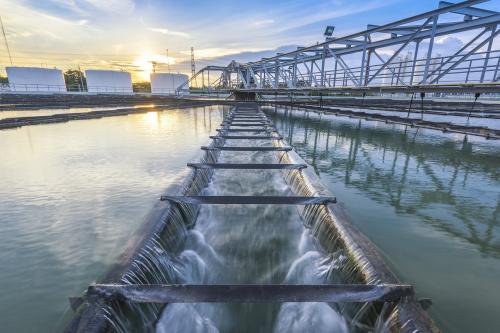Much like investing in water infrastructure, the country often overlooks the pressing need to invest in a skilled workforce to manage these systems. Nearly 1.7 million “water workers” construct, operate, and maintain water systems found in every region, whether employed in utilities, engineering firms, or other industries. And many water workers are in short supply due to a wave of retirements and a lack of younger talent, even though they earn more competitive wages, tend to only need a high school diploma or less, and develop valuable skillsets over time.
These workforce challenges are not unique to the water sector. Multiple other infrastructure employers are also struggling to hire, train, and retain more workers, especially those in the trades. If local water employers can design new ways to develop their workforce pipeline, the solutions could be replicated across the country and the broader infrastructure sector.
Developing these solutions, though, requires new techniques. In other words, local success depends on local innovation, ideally supported by broader regional collaborations and national investments. Building off a new “water workforce playbook” we developed through conversations with water and workforce leaders across the country, below are five steps that all types of localities can follow to accelerate their recruitment, training, and retention efforts:
-
Train and assign staff to expand recruitment efforts
Having leadership and staff in place willing to test out new ideas in support of water workforce development is common among the most forward-looking utilities, employers, and localities nationally. To reach younger, more diverse workers and students depends on clearly describing the nature of water work, the potential career pathways available, and the education and training needed. In turn, managers need to assign specific human resources, communications, and operations staff to carry out these tasks—and then make sure they’re trained to deliver a compelling and intuitive message, as agencies like the Baltimore Public Works Department have recently done through rebranding efforts.
-
Account for workforce demands as part of the long-term planning and budget process
Of course, not every locality has the financial, technical, or programmatic capacity to spearhead more ambitious recruitment efforts, nor do they always know what specific types of water workers and skillsets will be necessary to develop in years to come. For that reason, a detailed accounting and measurement of workforce demands alongside capital needs can help utilities, in particular, more strategically plan ahead. By identifying the most important mission-critical occupations in light of existing and potential pools of labor to fill these positions—and weighing these concerns as part of the budget process—utilities can better balance physical infrastructure investments with workforce investments. Regional efforts, such as BAYWORK, led by the San Francisco Public Utilities Commission and other utilities in California’s Bay Area, are doing just that.
-
Collaborate with other community partners to support more proactive outreach and engagement
Pioneering new water workforce development strategies often hinges on broader regional collaborations, especially for a sector that can be highly localized and fragmented. Urban and rural areas alike must overcome jurisdictional fragmentation and view their water workforce needs more regionally to raise awareness and achieve community buy-in for an economic issue that should resonate for all types of workers and employers. A broad set of community partners, from workforce development boards to educational institutions to labor groups, need to sit at the same table. For example, in addition to frequent regional conversations on hiring and training practices, the Louisville Metropolitan Sewer District hosts an annual summit called “Can You Dig It?,” where hundreds of local contractors, engineers, suppliers, and utility staff meet to discuss upcoming water projects and job opportunities.
-
Launch more flexible training platforms for younger and other nontraditional workers
To reach more prospective workers and ultimately expand the pool of skilled labor, utilities, other employers, and community partners need to create more flexible training programs, particularly for younger and other nontraditional candidates, including women and people of color who are frequently underrepresented across the sector. Existing apprenticeship programs, rigid job classifications, and other inflexible civil service hiring processes make it hard for many workers starting (or shifting) their careers to qualify for entry-level opportunities and gain needed work experience. However, developing new pre-apprenticeship programs, internships, and even “water boot camps” can expose workers to water careers, provide essential on-the-job training, and connect them with mentors. Through its Green Jobs Summer Ambassadors Program, for instance, the Camden County Municipal Utilities Authority has introduced high school students to green and water-related careers.
-
Support continued skills development to equip workers with needed competencies over time
Identifying and training new talent should only mark the beginning of a process where employers, educators, and other workforce groups are continually providing workers opportunities to learn and grow in the water sector. In other words, it is key to develop long-term careers for new and existing talent. For example, the development and implementation of new competency models can help better define needed skillsets and prepare workers to take on higher-level tasks. Customizing these models and viewing other operational needs in terms of emerging technologies should also be a priority, which some utilities like Atlanta’s Department of Watershed Management are already carrying out.
To be sure, these five steps do not capture the full range of actions that localities should take, but they offer a helpful guide for future planning and implementation. The varying scale and location of the country’s water workforce demands require continued conversations, collaborations, and actions at a local level—and increasingly at a national level too. To fully realize the economic promise offered in the water sector, utilities and all types of workforce leaders nationally must further stretch the reach of existing hiring, training, and recruitment strategies. Shining additional light on local innovations, replicating best practices across different regions, and providing durable technical and financial support for these efforts can help the country seize its water workforce opportunity.






Commentary
Five steps to prepare the next generation of water workers
June 29, 2018